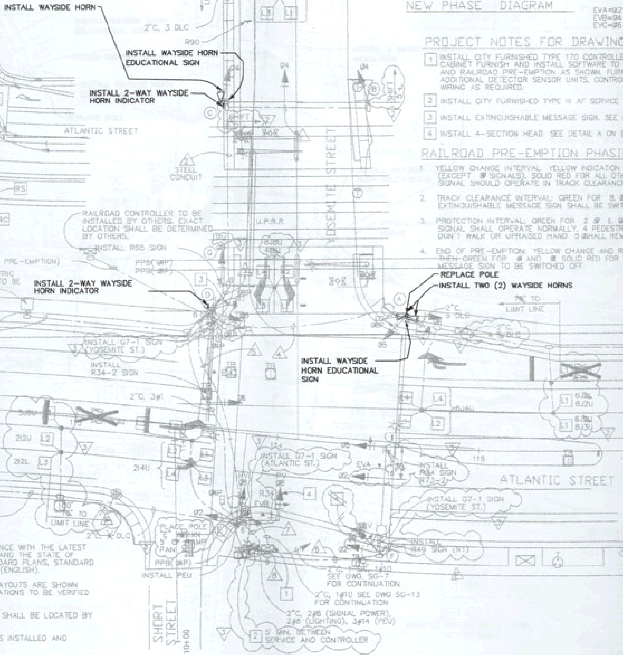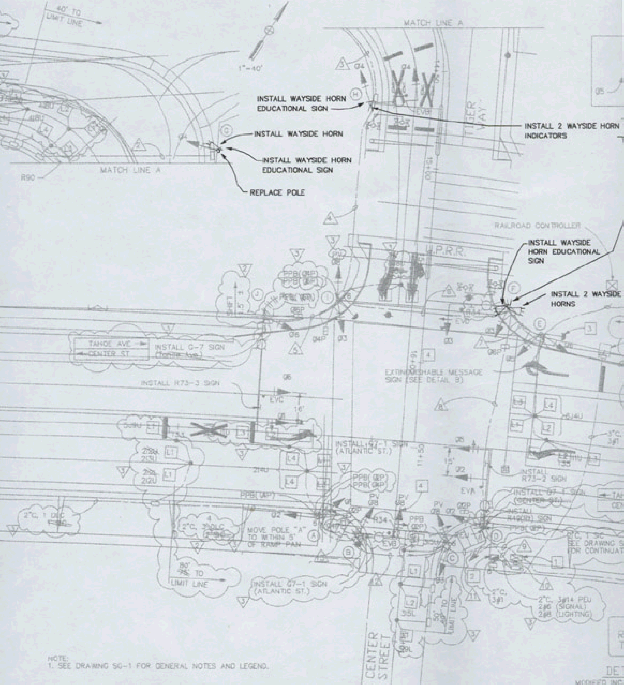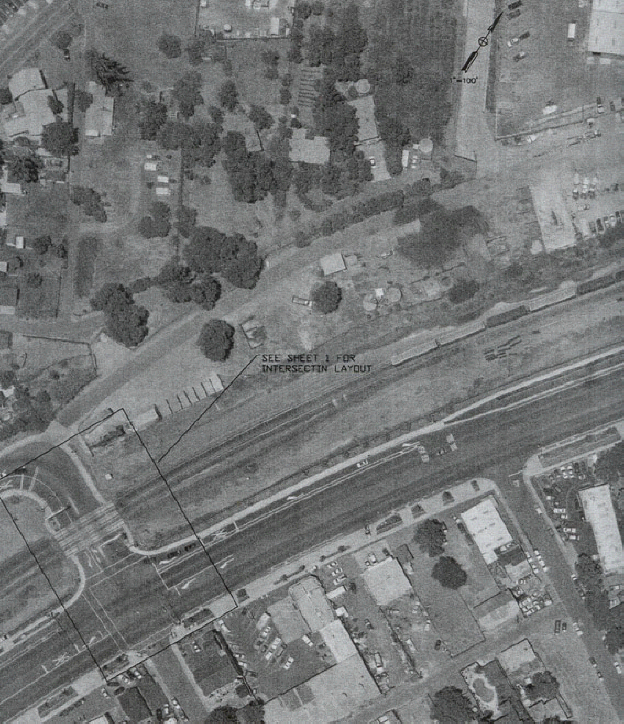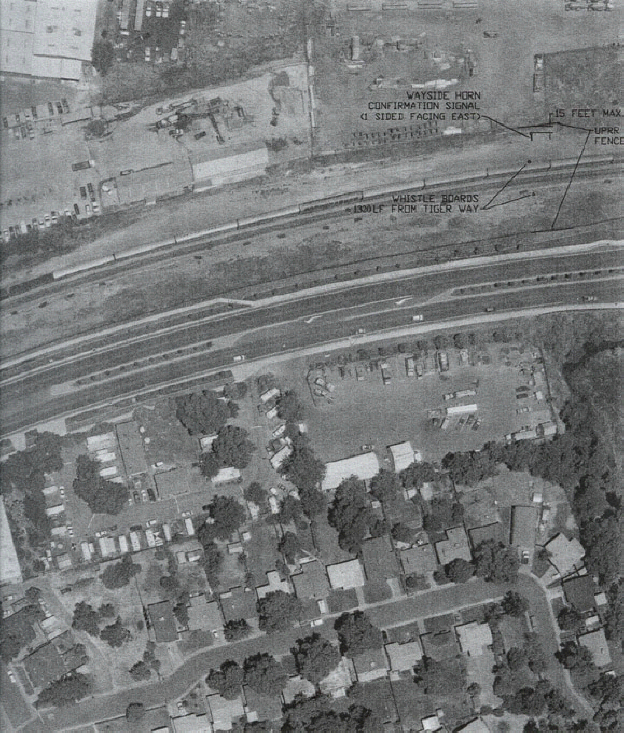Discussion
Public Utilities Code Section 7604 requires locomotive engineers to sound the train horn at a distance of at least 1,320 feet from the at-grade highway-rail crossing (crossing) and continue sounding the horn until the locomotive has crossed the street, road or highway. Previously, existing law imposed a civil fine on a railroad corporation that violated this provision and made it a misdemeanor for a person in charge of a locomotive engine to fail to sound this warning. This requirement was confirmed by California Attorney General's Opinion Number 86-504 of August 19, 1986, which states that a city may not adopt an ordinance prohibiting the sounding of train whistles within the city limits.
Senate Bill (SB) 1491 recognized the growing need to mitigate train horn noise without compromising the safety of the public. SB 1491, followed by Assembly Bill 1249 and SB 62, effective October 9, 2001, amended Public Utilities Code Section 1202 by adding the requirements for the CPUC to authorize pilot projects on an application by application basis to test the utility and safety of the stationary automated audible warning devices as an alternative to requiring trains to sound their horn as they approach crossings. Additionally SB 1491, and subsequently SB 62, amended Public Utilities Code Section 7604, eliminating the requirement that the warning device on the locomotive engine be sounded when approaching a crossing which has a permanently installed audible warning device that automatically sounds as the locomotive engine approaches the crossing. However, it still allows for the locomotive engineer to sound the locomotive mounted horn at the crossing if necessary.
At the federal level, the Swift Rail Development Act of November 2, 1994 added Section 20153 to Title 49 and directs the Secretary of Transportation, delegated to the Federal Railroad Administrator, to prescribe regulations requiring that a locomotive horn be sounded while each train is approaching and entering upon each public crossing. In addition, 49 U. S. C. 20153 provides the Federal Railroad Administration (FRA) the authority to exempt from this requirement, categories of rail operations or categories of crossings that: 1) are determined not to present significant risk with respect to loss of life or serious personal injury; 2) for which the use of a locomotive horn is impractical; or 3) for which supplementary safety measures fully compensate for the absence of the warning provided by the locomotive horn.
On January 13, 2000, the FRA published the Notice of Proposed Rulemaking and the Draft Environmental Impact Statement on the Use of Locomotive Horns at Highway-Rail Grade Crossings. The proposed rule would implement a statutory requirement that locomotive horns sound at each highway-rail grade crossing unless certain exceptions are met. Based on the study by the Volpe National Transportation System Center of the U. S. DOT, Field Evaluation of a Wayside Horn at a Highway Grade Crossing, June 1998, the FRA continues to identify opportunities for developing data analysis to ensure confidence that the wayside horn fully compensates for the absence of the train horn at any individual crossing. In accordance with the proposed rule, the FRA will be an active participant in the design, monitoring and evaluation of this pilot project.
The City filed its application on September 20, 2000. The City requests authority to install Stationary Horn Warning Systems at Yosemite Street, CPUC Crossing No. 001A-106.9, and Tiger Way, CPUC Crossing No. 001A-107.20, across the tracks of the UPRR in the City of Roseville in Placer County.
The warning devices at the Yosemite Street and Tiger Way crossings were installed in 1999. Both crossings are equipped with two CPUC Standard No. 9-A (a Standard No. 9 with additional flashing lights on cantilevered mast arm), and are wired with constant-time-warning circuitry. Both streets have raised medians, concrete panel surfacing, and sidewalks on both sides of the roadway. Three tracks run perpendicular to the street. Yosemite Street and Tiger Way are within 50 feet of Atlantic Street, which runs parallel to the railroad tracks. Both intersections; Yosemite and Atlantic Street, and Tiger Way and Atlantic Street; are signalized and interconnected with the railroad crossing warning system such that vehicular movements at the intersection are preempted by train movements through the crossing. The existing crossing warning devices will not require any modifications.
The automated horn system (AHS) will be placed on a separate pole from the other devices and signals, as shown in Appendix A. At the Yosemite Street crossing, the horns will be directed toward southbound traffic on Yosemite Street and vehicular traffic on Atlantic Street. At the Tiger Way crossing, the horns will be directed toward southbound traffic on Tiger Way, vehicular traffic on Atlantic Street and northbound traffic on Center Street. An automatic horn indicator, an orange colored 18-inch high "X" indication using LED lights, will be installed at each crossing directed down the tracks in both directions, and on both sides, and remain activated at all times to indicate the proper functioning of the AHS for the locomotive engineers. If ever the AHS malfunctions the automatic horn indicator will go dark.
UPRR will instruct all locomotive engineers operating on this track as to the operation of the AHS and revise its operating rules accordingly. UPRR will also instruct locomotive engineers to cease sounding the train mounted horn on approach to the crossings if the AHS is functioning properly as indicated by the automatic horn indicator; unless at their discretion, the locomotive engineers believe it is necessary to sound the train mounted horn to provide additional warning. If under various weather or lighting conditions, the locomotive engineer cannot see the automatic horn indicator, the locomotive engineer will sound the train mounted horn. UPRR will also install and maintain a sign, also referred to as a whistle board, down the track from the crossings to remind locomotive engineers of the automated horn indicator and to ensure that locomotive engineers have adequate time to decide to sound the train mounted horn, if necessary.
The City shall bear the full cost of installation and maintenance of the AHS during the pilot project. Prior to the start of the operation of the AHS, the City shall inform the local community via information media as to the operation of the AHS. The City shall monitor the effectiveness of the AHS by use of video technology, event recorders, and resident and locomotive engineer surveys, as described in the Monitoring Program in Appendix B. The City will report, on a quarterly basis, the results of the monitoring program to UPRR, FRA, and the CPUC Consumer Protection and Safety Division (CPSD). The City shall prepare a report of preliminary assessments and recommendations, and deliver it to CPSD no later than January 31, 2004, in order for the CPUC to fulfill its obligation to report back to the Legislature in March of 2004. At the end of the pilot project, the City will prepare and deliver to CPSD a final report making recommendations as to the future use of the AHS.
The City and UPRR have entered into an agreement as to the cost, maintenance, and any liability as a result of the installation of the AHS. A copy of the agreement is attached as Appendix C.
The California Environmental Quality Act (Public Resources Code Section 21000 et seq., hereafter "CEQA") applies to discretionary projects to be carried out or approved by public agencies. A basic purpose of CEQA is to inform governmental decision-makers and the public about the potential significant environmental effects of the proposed activities. (CEQA Guideline Section 15002.)
This proposed project involves the installation of a wayside horn. Section 15301(f) of the CEQA Guidelines provides a categorical exemption from CEQA review, for the addition of safety or health protection devices used during construction or in conjunction with existing structures and facilities. In addition, the CPUC Rule of Practice and Procedure 17.1(h)(A)(5) provides a CEQA exemption for alterations in railroad crossing protection, and Rule 17.1(h)(A)(6) provides a CEQA exemption for crossing alterations described in Guideline 15301(c) and (f). Based on these exemptions we find that installation of the wayside horn does not require a CEQA review.
In Resolution ALJ 176-3049 dated October 19, 2000, the CPUC preliminarily categorized this application as ratesetting, and preliminarily determined that hearings were not necessary. No protests have been received. Given these developments, a public hearing is not necessary, and it is not necessary to disturb the preliminary determinations made in Resolution ALJ 176 -3049.
An amendment to the application was filed by the City on April 16, 2002, and published on the CPUC's Daily Calendar on April 18, 2002. The amendment consists of replacing all references to Tahoe Street with Tiger Way in this application.
Application 00-09-063, as amended, meets the filing requirements of the CPUC's Rules of Practice and Procedure
The Rail Crossing Engineering Section (RCES) and Railroad Operations and Safety Section of the CPSD have inspected the site of the proposed pilot project. As provided for in Public Utilities Code Section 1202; RCES examined the need for and safety of the proposed pilot project and recommends that the requested authority be granted as a pilot project to evaluate the AHS.
This is an uncontested matter in which the decision grants the requested relief. Therefore, pursuant to California Public Utilities Code § 311(g)(2), the otherwise applicable 30-day period for public review and comment is being waived.
Assignment of Proceeding
Richard Clark is the assigned Examiner in this proceeding.
Findings of Fact
1. Notice of the application was published in the CPUC Daily Calendar on October 4, 2000. No protests have been filed.
2. The City filed an amendment to the application on April 16, 2002, and published in the CPUC's Daily Calendar on April 18, 2002. The amendment consists of replacing all references to Tahoe Street with Tiger Way in this application.
3. The City requests authority to install and maintain the AHS at Yosemite Street (001A-106.9), and Tiger Way (001A-107.20) crossings as a pilot project as permitted by Public Utilities Code Section 1202.
4. The CPUC is a responsible agency for this project under the CEQA.
5. This project is categorically exempt from the requirements of CEQA.
Conclusions of Law
1. The application is uncontested and a public hearing is not necessary.
2. The application should be granted as set forth in the following order.
IT IS ORDERED that:
1. The City of Roseville (City) is authorized to install and maintain a stationary horn warning system at two public crossings over the Union Pacific Railroad Company's main line at Yosemite Street (001A-106.9) and at Tiger Way (001A-107.20) in the City of Roseville as a pilot project as permitted by Public Utilities Code Section 1202 for the purpose of testing the utility and safety of stationary automated warning devices.
2. Clearances shall be in accordance with California Public Utilities Commission General Order (GO) 26-D.
3. Walkways shall conform to GO 118. Walkways adjacent to any tracks subject to rail operations shall be maintained free of obstructions and shall be promptly restored to their original condition in the event of damage during construction.
4. Construction and maintenance costs shall be borne in accordance with the agreement that has been entered into between the parties as shown in Appendix C.
5. The City will report quarterly, submit a preliminary assessment report to the Consumer Protection and Safety Division no later than January 31, 2004, and submit a final report as detailed in the Monitoring Plan in Appendix B.
6. This authorization shall expire if not exercised within three months unless time is extended or if the above conditions are not complied with. Authorization may be revoked or modified if public convenience, necessity, or safety so require.
7. This application is granted as set forth above.
8. Application 00-09-063 is closed.
This order is effective today.
Dated December 17, 2002 , at San Francisco, California.
LORETTA M. LYNCH
President
HENRY M. DUQUE
CARL W. WOOD
GEOFFREY F. BROWN
MICHAEL R. PEEVEY
Commissioners







